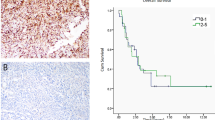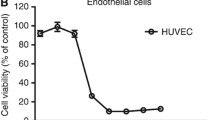Summary
Purpose: Enzastaurin (LY317615) is a novel serine/threonine kinase inhibitor, targeting Protein Kinase C-beta (PKC-β), and PI3K/AKT pathways to inhibit angiogenesis and tumor cell proliferation. The aims of this study were to determine whether Enzastaurin has direct antitumor activity against freshly explanted tumor cells and to correlate mRNA expression of genes related to the proposed mechanism of action of enzastaurin with in vitro chemosensitivity. Experimental Design: Freshly biopsied tumor cells were studied using soft-agar cell cloning experiments (SACCE) to determine the in vitro chemosensitivity to enzastaurin. An aliquot of the same tumor specimens was shock-frozen and total RNA was isolated for standardized multiplex rt-PCR experiments for gene expression of PKC-β1, PKC-β2, IL-8, IL-8RA, IL-8RB, Glycogen Synthase Kinase 3 beta (GSK-3β) and TGF-β1. Correlations, threshold optimization, sensitivity, specificity, and efficiency were analyzed using the appropriate statistical methodologies. Results: Seventy-two tumor samples were collected and 63 were fully evaluable. Low levels of mRNA expression of GSK-3β and high levels of mRNA expression of IL-8 were highly significantly correlated with chemosensitivity to enzastaurin. Optimization analyses demonstrated threshold values of 4,000 copies for IL-8 and three copies for GSK-3β relative to 104 copies of β-actin. However, no correlation between mRNA expression of PKC-β1, PKC-β2, IL-8RA, IL-8RB and chemosensitivity to enzastaurin was observed. Expression of TGF-β1 mRNA was not detectable in the specimens investigated. Conclusions: mRNA expression levels of IL-8 and GSK-3β correlate with antitumor activity of enzastaurin. These results form a rational basis for clinical trials to evaluate the expression of these genes as potential predictors for treatment outcome after enzastaurin chemotherapy.


Similar content being viewed by others
References
Folkman J (1989) What is the evidence that tumors are angiogenesis dependent? J Natl Cancer Inst 82:4–6
Neufeld G, Cohen T, Gengrinovitch S, Poltorak Z (1999) Vascular endothelial growth factor (VEGF) and its receptors. FASEB J 13:9–22
Ferrara N (2004) Vascular endothelial growth factor: basic science and clinical progress. Endocr Rev 25(4):581–611
Steiner HH, Karcher S, Mueller MM, Nalbantis E, Kunze S, Herold-Mende C (2004) Autocrine pathways of the vascular endothelial growth factor (VEGF) in glioblastoma multiforme: clinical relevance of radiation-induced increase of VEGF levels. J Neurooncol 66(1–2):129–138
Wang ES, Teruya-Feldstein J, Wu Y, Zhu Z, Hicklin D, Moore MA (2004) Targeting autocrine and paracrine VEGF receptor pathways inhibits human lymphoma xenografts in vivo. Blood 104(9):2893–2902
Ferrara N (2002) Role of VEGF in physiologic and pathologic angiogenesis: therapeutic implications. Semin Oncol 29(Suppl 16):10–14
Graff JR, McNulty AM, Hanna KR et al (2005) The protein kinase C beta-selective inhibitor, Enzastaurin (LY317615.HCl), suppresses signaling through the AKT pathway, induces apoptosis, and suppresses growth of human colon cancer and glioblastoma xenografts. Cancer Res 65(16):1–9
Gescher A (1998) Analogs of staurosporine: potential anticancer drug? Gen Pharmacol 31(5):721–728
Jarvis WD, Grant S (1999) Protein kinase C targeting in antineoplastic treatment strategies. Invest New Drugs 17(3):227–240
Parker PJ (1999) Inhibition of protein kinase C—do we, can we, and should we? Pharmacol Ther 82(2–3):263–267
Xia P, Aiello LP, Ishii H et al (1996) Characterization of vascular endothelial growth factor’s effect on the activation of protein kinase C, its isoforms, and endothelial cell growth. J Clin Invest 98(9):2018–2026
Takahashi T, Ueno H, Shibuya M (1999) VEGF activates protein kinase C-dependent, but Ras-independent Raf-MEK-MAP kinase pathway for DNA synthesis in primary endothelial cells. Oncogene 18(13):2221–2230
Yoshiji H, Kuriyama S, Ways DK et al (1999) Protein kinase C lies on the signaling pathway for vascular endothelial growth factor-mediated tumor development and angiogenesis. Cancer Res 59:4413–4418
Gokmen-Polar Y, Murray NR, Velasco MA, Gatalica Z, Fields AP (2001) Elevated protein kinase C bII is an early promotive event in colon carcinogenesis. Cancer Res 61:1375–1381
Murray NR, Davidson LA, Chapkin RS, Clay Gustavson W, Schattenberg DG, Fields AP (1999) Overexpression of protein kinase C betaII induces colonic hyperproliferation and increased sensitivity to colon carcinogenesis. J Cell Biol 145:699–711
Zhang J, Anastasiadis PZ, Liu Y, Thompson EA, Fields AP (2004) Protein kinase C (PKC) betaII induces cell invasion through a Ras/Mek-, PKCiota/Rac 1-dependent signaling pathway. J Biol Chem 279(21):22118–22123
Shipp MA, Ross KN, Tamayo P (2002) Diffuse large B-cell lymphoma outcome prediction by gene-expression profiling and supervised machine learning. Nat Med 8:68–74
da Rocha AB, Mans DR, Regner A, Schwartsmann G (2002) Targeting protein kinase C: new therapeutic opportunities against high-grade malignant gliomas? Oncologist 7:17–33
Faul MM, Gillig JR, Jirousek MR (2003) Acyclic N-(azacycloalkyl)bisindolylmaleimides: isozyme selective inhibitors of PK-b. Bioorg Med Chem Lett 13:1857–1859
Keyes K, Cox K, Teadway P et al (2002) A in vitro tumor model: analysis of angiogenic factor expression after chemotherapy. Cancer Res 62(19):5597–5602
Keyes KA, Mann L, Sherman M (2004) LY317615 decreases plasma VEGF levels in human tumor xenograft-bearing mice. Cancer Chemother Pharmacol 53:133–140
Oberschmidt O, Eismann U, Schulz L et al (2005) Assessment of in vitro synergistic antitumor activity of Enzastaurin and Pemetrexed against thyroid cancer cell lines. Onkologie 28(Suppl 3):271
Hanauske A-R, Oberschmidt O, Hanauske-Abel HM, Eismann U (2007) Antitumor activity of enzastaurin (LY317615.HCl) against human cancer cell lines and freshly explanted tumors investigated in in vitro soft-agar cloning experiments. Invest New Drugs 25:205–210
Vogel M, Hilsenbeck SG, Depenbrock H et al (1993) Preclinical activity of taxotere (RP56976, NSC628503) against freshly explanted clonogenic human tumor cells: comparison with taxol and conventional antineoplastic agents. Eur J Cancer 29A(14):2009–2014
Hanauske AR, Hanauske U, von Hoff DD (1985) The human tumor cloning assay in cancer research and therapy. Curr Probl Cancer 9:1–50
Hanauske AR, Hilsenbeck SG, von Hoff DD (1996) The human tumor cloning assay. In: Schilsky RL, Milano GA, Ratain MJ (eds) Principles of antineoplastic drug development and pharmacology. Marcel Dekker, New York, pp 5–27
Hanauske AR, Hilsenbeck SG, von Hoff DD (2004) Human tumor screening. In: Teicher BA, Andrews PA (eds) Cancer drug discovery and development: Anticancer drug development guide: preclinical screenings, clinical trials, and approval, 2nd edn. Humana, Totowa, NJ, pp 63–76
Britten CD, Izbicka E, Hilsenbeck S et al (1999) Activity of the multitargeted antifolate LY231514 in the human tumor cloning assay. Cancer Chemother Pharmacol 44(2):105–110
Wang Q, Zhou Y, Wang X, Evers BM (2006) Glycogen synthase kinase-3 is a negative regulator of extracellular signal-regulated kinase. Oncogene 25(1):43–50
Grzesiak JJ, Smith KC, Burton DW, Deftos LJ, Bouvet M (2005) GSK3 and PKB/Akt are associated with integrin-mediated regulation of PTHrP, IL-6, IL-8 expression in FG pancreatic cancer cells. Int J Cancer 114(4):522–530
R Development Core Team (2005) R: a language and environment for statistical computing. R Foundation for Statistical Computing, Vienna, Austria. ISBN 3-900051-07-0, URL http://www.R-project.org.
Acknowledgments
We are thankful for the highly skilful administrative assistance of Mrs. Sibylle Kriebel during the conduct of this project. This project was supported by a grant from Eli Lilly and Co., Indianapolis, USA.
Author information
Authors and Affiliations
Corresponding author
Additional information
The first and second authors have contributed equally to this project.
Rights and permissions
About this article
Cite this article
Hanauske, AR., Eismann, U., Oberschmidt, O. et al. Correlations of mRNA expression and in vitro chemosensitivity to enzastaurin in freshly explanted human tumor cells. Invest New Drugs 26, 215–222 (2008). https://doi.org/10.1007/s10637-007-9095-y
Received:
Accepted:
Published:
Issue Date:
DOI: https://doi.org/10.1007/s10637-007-9095-y




